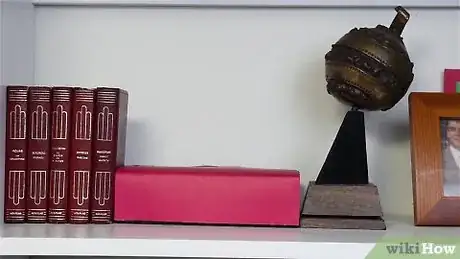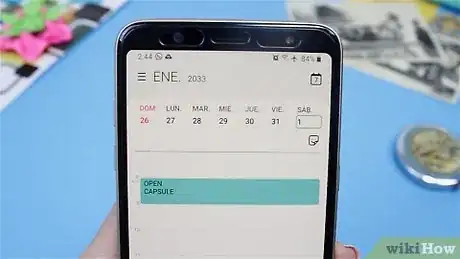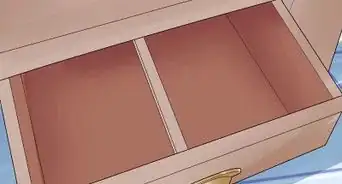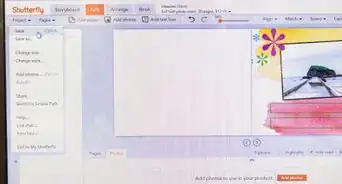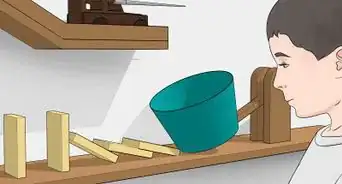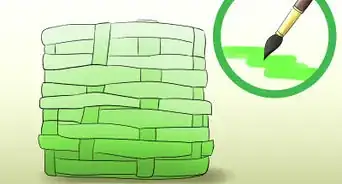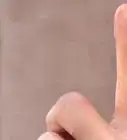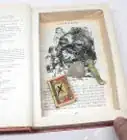This article was co-authored by wikiHow Staff. Our trained team of editors and researchers validate articles for accuracy and comprehensiveness. wikiHow's Content Management Team carefully monitors the work from our editorial staff to ensure that each article is backed by trusted research and meets our high quality standards.
There are 9 references cited in this article, which can be found at the bottom of the page.
The wikiHow Video Team also followed the article's instructions and verified that they work.
This article has been viewed 695,795 times.
Learn more...
Time capsules are fun to make, and even more, fun to open years down the line. A time capsule can be any container that holds objects meant for people to open in the future, whether that be in 5, 10, or even 100 years. A good time capsule will hold its contents safely, preserving them for a future version of yourself, your grandchildren, or even a stranger. Soon you will have the skills to create a time capsule that will thrill and fascinate someone in the future.
Steps
Sample Time Capsule Letters
Assembling Your Contents
-
1Choose an audience for your time capsule. Think about who your time capsule is for. This will help you pick contents, a location for the capsule, and a container. Whether you plan to open the capsule yourself, you would rather have your grandchildren open it, or you want a stranger from the distant future to stumble upon it, you should be clear about your intent.
- If you are struggling to find an audience, think about what kind you would most like to open. Do you wish your grandparents had left you a time capsule filled with memorabilia and handwritten notes? Does the thought of opening a 150 year old capsule left by someone lost to time long ago thrill you?
-
2Make a list of possible objects to include for your audience.. Depending on your audience, you may have different priorities for your contents. You can always collect more objects for your time capsule than you end up putting in. Your only limits are space and the ability of your capsule contents to be safely stored.[1]
- If the capsule is for yourself, focus on personal mementos of your life as it is right now. Things like a pair of earbuds you wore every day for 2 years, an old key, or a takeout menu from a favorite restaurant will bring memories back in just a few years.
- For a time capsule that you plan to pass down to your children or grandchildren, find things that will interest them about your life and your world. Both personal objects of significance to you and your family, like wedding invitations, and things that depict the state of the world, like technology, are good choices.
- If your capsule is for people in the far future to uncover long after you are gone, focus on the era you are in. Things that may seem to be of little value now may be fascinating to someone in 75 or 100 years.
Advertisement -
3Put toys in the capsule for kids. If you are making the time capsule with children, or for future children, toys and simple games can be a way to excite kids about the experience. Of course, don't lock a child's favorite toy away for years and years, but a handful of toys from when they were younger can help them get interested.
- Toys can change over the years more than you might think, and for a child they can be fondly remembered years later.
-
4Pick out some current newspapers or magazines. For a more general audience, print media showing current events or trends is a good choice to carry into the future a sense of what it was like to be alive in your era. You can even cut out headlines or articles from the day the capsule will be put in its resting place.[2]
- Be sure to keep the paper in plastic sleeves to ensure that it is preserved.
-
5Store journals, letters, and photographs for a personal touch. Whether or not the time capsule is for you and your family, many people find it rewarding to read messages between people from the past. Journals and photographs each provide a captivating look at another person's life, as well.[3]
- These are especially vulnerable to damage, so protect them in special archival sheets if the capsule will last more than 5 years.
-
6Choose any other objects that are compact and non-perishable. There is no limit to what you can keep in a time capsule, so long as it will fit and won't reach its expiration date before you want it to be opened. Most food and drink are not great candidates for your time capsule, as they are likely to rot or spoil before the opening date.
- If you are out of ideas for what to put in your time capsule, run through your daily activities in your head. What objects do you use? What do you look at? What do you read? Asking yourself these questions can give you many new ideas.
-
7Write and enclose a letter, if desired. This gives you an opportunity to tell your future audience about daily life, current fads, fashions, attitudes, and trends, what you think the future might look like, and anything else that you would like to say. You can also mention your intentions in creating the capsule.[4]
- Write the letter as though it were addressed directly to whoever will open the capsule. This will give it a much more personal feeling than a letter that is closer to a list of facts than a piece of communication.
-
8Make an inventory of everything in the capsule. Write down all of the contents and place the list in the capsule and in your records. This will help future openers know that everything is in place, and help you remember what you put in the capsule.[5]
Choosing a Container
-
1Choose a duration for your time capsule. For a personal time capsule, 10 to 30 years may be enough, whereas a generational time capsule meant for your grandchildren may need to last 60 to 70 years. If you want your capsule to be opened at an even later date, you will want to start planning the logistics.
- It's okay to not have a specific date for the capsule to be opened. Maybe you want to open it when you are married or reach retirement.
-
2Plan for the worst wear and tear. No matter where you plan to store your time capsule, damage could ruin the contents before anyone ever sees them. You should keep the contents wrapped separately from one another and choose a container that can withstand worse than it is likely to endure.[6]
-
3Use a shoebox, bin, or old suitcase for a short-term, indoor option. If your capsule is only supposed to last 5 to 10 years, a simple, everyday container will keep the contents safely tucked away and easily portable, without the risk of outdoor stowing.
- Keep in mind that a capsule made of cardboard or paper may be completely destroyed by fire, flood, or other natural disaster.
-
4Use a coffee canister for a simple, short-term choice. If you have a used coffee tin around, the aluminum will hold up below ground for around 10 years. To avoid getting water past the lid, bury the container inside a Ziploc bag, or other airtight plastic wrapping.[7]
-
5Select a highly weatherproof container for long-term stowage. If you plan to place the time capsule outdoors or bury the time capsule, select a container that is likely to survive, like a commercial or home-built aluminum, stainless steel, or PVC plastic capsule.[8]
- One example of a sturdy home-built PVC container is a PVC tube with an end cap attached with PVC cement and a test cap lid that can be screwed tightly into the pipe.[9]
- Consider using desiccant "gel bags", such as those included in the packaging of electronic goods and in bottles of vitamin tablets. These help to absorb any moisture that may have been present at the time of encapsulation and help to kill microbes that may make some of your items perish.
Finding a Location
-
1Use your imagined audience to decide where to put the capsule. If you are planning on opening the time capsule yourself, you may be able to store it in your own home or buried in your backyard. For an audience in the future aside from your family, a spot that is off of private property may be best.
- Be sure to store your outdoor capsule in a place that is safe from development and construction, like just outside a national park or landmark, particularly if you choose to bury it.
-
2Choose burial for a traditional time capsule approach. While burial may not be the best choice, for several reasons, it is certainly the classic way to store your capsule. Buried capsules are very likely to be forgotten or lost, and being underground makes the contents much more susceptible to damage from moisture.[10]
- Another positive side of underground storage is that it is less likely to be removed or opened early as it might be indoors. Outdoor storage has a better chance of staying in one place.
-
3Store your time capsule indoors for a safer alternative. Out of the elements, indoor time capsules are a secure alternative to storing them underground. While they may be more tempting to open and a little less captivating than buried time capsules, you should still consider an indoor approach for shorter term storage.
-
4Choose an outdoor, above-ground option for a fun challenge. One interesting alternative is to store your time capsule items in a stainless steel vacuum food jar hidden inside a camouflaged polyurethane hollow rock or log.[11]
- These above-ground time capsules are called Geocapsules and can provide a further level of adventure to the time capsule experience.
Storing the Time Capsule
-
1Mark the container with the current date and the intended opening date. This ensures that the opener knows the exact origin of your time capsule and, if they found it unintentionally, knows when to open it.[12]
- Avoid using ink to mark the outside of a buried capsule. An engraving would hold up best, but weather-grade paint is another good option.
- Noting these dates on the outside and inside of the capsule creates extra assurance.
-
2Do something to remind yourself or others about the time capsule. At minimum, you will need to record the location and intended opening date on paper, digitally, and in a secure location. If you keep a calendar, set reminders each year, or schedule an email to be sent to you on a certain date.[13]
- Consider writing the location and opening date in your will, or leave a letter with a grandchild containing instructions.
-
3Make extra arrangements for a time capsule that will outlive you. If your time capsule is intended for retrieval years or decades after its original placement, make doubly sure that several people know of its exact location and surroundings. Ask them to hold the information for safekeeping, passing it along if necessary.
- Take photographs of your placement, identify GPS coordinates, and write down all data important for relocating the precise location.
- Register the time capsule to make it feel more official, and give the capsule a higher chance of being found if all else fails.[14]
-
4Seal the time capsule and store it. Be sure to seal it tightly and completely. Remember to use a plastic bag on the outside as well for outdoor storage. If it's a personal time capsule, the hard part will be resisting the urge to open it, but soon you will forget all about it until you are reminded![15]
-
5Place a marker of some kind on the exact site of a buried capsule. Even if it is just a painted rock, keeping some kind of visible, yet not overt, sign of the spot to dig for the capsule will help you or someone else in the future avoid losing the treasure.
Community Q&A
-
QuestionHow do I write a letter to my granddaughter in my capsule?
 Community AnswerWrite something heartfelt, and what it was like when you were her age, or like her. Write something you think she would like, and things that you like right now. Maybe you would want to write down some of your favourite recipes and then she would be able to have recipes for her kids if she ever get to have any. Tell her about your way of life right now and the things you've achieved in life and still hope to achieve. Offer her words of wisdom for when she reaches your age now.
Community AnswerWrite something heartfelt, and what it was like when you were her age, or like her. Write something you think she would like, and things that you like right now. Maybe you would want to write down some of your favourite recipes and then she would be able to have recipes for her kids if she ever get to have any. Tell her about your way of life right now and the things you've achieved in life and still hope to achieve. Offer her words of wisdom for when she reaches your age now. -
QuestionWould my time capsule be damaged if I used a metal lunch box and sealed it with duct tape?
 Community AnswerNo, if anything that would protect the capsule, as well as provide a sturdy container for the items
Community AnswerNo, if anything that would protect the capsule, as well as provide a sturdy container for the items -
QuestionWhat sorts of things can I put inside of it?
 Community AnswerTry putting in some things that are currently popular or new. This includes things like electronics, music, news paper clippings, small accessories, coins, etc. You don't want to put something in that you bought a decade ago.
Community AnswerTry putting in some things that are currently popular or new. This includes things like electronics, music, news paper clippings, small accessories, coins, etc. You don't want to put something in that you bought a decade ago.
Warnings
- Consider the life span of other objects, too. A plastic toy might weather the years better than a book or magazine, especially if the time capsule is ever exposed to water.⧼thumbs_response⧽
- Don't put perishable items in your time capsule. Nobody wants a 40-year-old peanut butter sandwich!⧼thumbs_response⧽
- Always treat antiques, historical artifacts, and other records of the past with care and respect so that their messages can reach future generations, too.⧼thumbs_response⧽
References
- ↑ https://www.nytimes.com/2015/11/08/magazine/how-to-make-a-time-capsule.html
- ↑ https://www.loc.gov/preservation/resources/educational/timecapsule/ISUL.pdf
- ↑ https://www.loc.gov/preservation/resources/educational/timecapsule/ISUL.pdf
- ↑ https://www.nytimes.com/2015/11/08/magazine/how-to-make-a-time-capsule.html#
- ↑ https://www.loc.gov/preservation/resources/educational/timecapsule/ISUL.pdf
- ↑ https://www.loc.gov/preservation/resources/educational/timecapsule/ISUL.pdf
- ↑ https://www.nytimes.com/2015/11/08/magazine/how-to-make-a-time-capsule.html#
- ↑ https://www.mnhs.org/preserve/conservation/reports/timecapsule.pdf
- ↑ https://www.popularmechanics.com/home/how-to-plans/how-to/g2183/how-to-build-an-indestructible-time-capsule/
- ↑ https://www.mnhs.org/preserve/conservation/reports/timecapsule.pdf
- ↑ https://dos.myflorida.com/library-archives/archives/preserve/time-capsule/
- ↑ https://www.nytimes.com/2015/11/08/magazine/how-to-make-a-time-capsule.html#
- ↑ https://crypt.oglethorpe.edu/international-time-capsule-society/most-wanted-time-capsules/
- ↑ https://crypt.oglethorpe.edu/international-time-capsule-society/register-your-time-capsule/
- ↑ https://www.loc.gov/preservation/resources/educational/timecapsule/FordCC.pdf
About This Article
To create a time capsule, start by finding a shoebox, bin, or old suitcase. Then, pack it with items that show what it’s like to live today. For example, pack a recent newspaper or magazine, currency, fashionable clothes, photographs, or packaging from your favorite candies. You can also write a description of what it’s like to live today so you can see how much the world has changed when you open the time capsule. For instance, write about current fads, attitudes, and hot topics of the day. When you’ve finished making your time capsule, you can store it inside to protect it from the elements, or you can bury it outside. If you choose to bury your time capsule, add a few gel bags to reduce moisture and stop your items decaying over the years. For more tips, including how to set a reminder to open your time capsule, read on!







